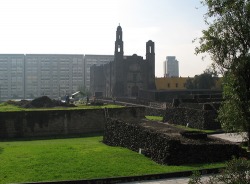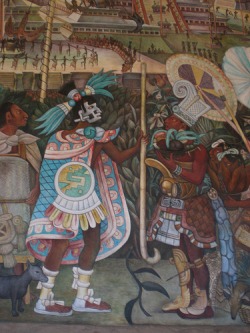New World Before Europeans
As with North American Indians, cultures in South America held similar beliefs. Both the Aztec and the Inca were polytheistic as well. The Aztecs centered their beliefs around attempting to control nature and its destructive power. These people used three different calendars, each to keep track of when to worship certain gods. Similarly, the Incas worshiped gods of nature and developed a religious calender to keep track of days of worship. One elaborate ceremony held annually by the king was named IntipRaimi, in which a feast and celebration was held for the sun god to give thanks. Precious offerings were made to the god. It is clear that although the Europeans believed the New World to be a place of savages, that is not the case. Religion played just as large of a part in Aztec and Incan life as it did in the lives of their Old World counterparts. The differences in the religion however, caused the Europeans to look down upon the native cultures with condescension and disapproval. The newcomers could not look beyond the superficial differences in the cultures, and thus felt the it was necessary to replace the original beliefs with European ones.
One of the most disapproved of the native rituals were the sacrifices. Both the Aztec and Incan cultures used sacrifices as a way of appeasing their gods. One particularly bloody example is the enthronement of an Incan king in which two hundred children were sacrificed. Viewed by Europeans as acts of the Devil, these sacrifices angered and outraged the Old World. Ironically, the actions taken by the Conquistadors to stop these sacrifices led to more death and suffering. “The Spanish were ruthless in killing Aztec priests, who they believed practiced an evil form of black magic.” (Benson) Further, those who refused to convert to Catholicism were often tortured. Just like the Aztecs, the Spanish performed acts of violence and bloodshed in the name of religion. Although the Spanish claimed to be different or better than the Aztecs, both cultures were remarkably similar.
Following the capture of Tenochtitlán, thousands of Aztecs were enslaved and used to build a new city in its place, Mexico City. “...wherever the Spanish found an Aztec temple, they built a Roman Catholic church right on top of it or, if this was not possible, right beside it.”(Benson). Aside from building a new capitol, slave labor was used for agriculture and manufacturing. The indigenous population was used to mass produce crops such as tobacco, cacao, along with products such as red dye. As a result, products that were previously used locally now had new market as they were shipped to Europe. The economy of Europe linked with that of the Americas as new products and ideas were exchanged. In this way, both Europeans and Aztecs were influenced by each other and experienced new changes in this process that we now call globalization.
Wenli


